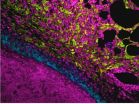(Press-News.org) OAK BROOK, Ill. (January 31, 2013) – Researchers using a newly approved advanced computed tomography (CT) system were able to significantly reduce radiation exposure in patients undergoing coronary CT angiography (CCTA), according to a new study published online in the journal Radiology.
"Radiation exposure during diagnostic imaging is a substantial public concern," said Marcus Y. Chen, M.D., lead author of the study from the advanced cardiovascular imaging laboratory at the National Institutes of Health in Bethesda, Md. "Minimizing radiation exposure while maintaining diagnostic-quality scans is clearly feasible with this new second-generation 320–detector row CT scanner."
CCTA is a valuable noninvasive imaging exam with high diagnostic accuracy. The exam is particularly effective and safe for the exclusion of significant coronary artery disease in patients arriving at the emergency department with acute chest pain. However, the clinical benefit of CCTA has been tempered by concerns of potential future cancer risk from the radiation exposure. Technologic advances have evolved to allow radiologists to not only reduce radiation exposure to the patient but also to improve image ac¬quisition.
This study represents the initial coronary angiography results obtained with a prototype 320–detector row CT system recently approved by the U.S. Food and Drug Administration. The new system holds several technical advantages over its first-generation counterpart, including a gantry rotation time of 275 milliseconds, wide volume coverage, iterative reconstruction, automated exposure control, and a larger x-ray power generator.
For the study, Dr. Chen and colleagues performed contrast–enhanced CCTA with a second-generation 320-slice CT system on 107 adult patients (mean age, 55.4) and compared radiation exposure and image quality to those of CCTA exams previously performed on 100 patients using a first-generation 320-slice scanner.
Effective radiation dose was estimated by multiplying the dose-length product—a calculation of the radiation dose for a series of scans or entire examination—by an effective dose conversion factor and reported with size-specific dose estimates (SSDEs). Image quality was evaluated by two independent readers.
The median radiation dose was 0.93 millisieverts (mSv) with the second-generation unit and 2.67 mSv with the first-generation unit. The median SSDE was 6.0 milligray (mGy) with the second-generation unit and 13.2 mGy with the first-generation unit. Overall, the radiation dose was less than 0.5 mSv for 23 of the 107 CT angiography examinations (21.5 percent), less than 1 mSv for 58 (54.2 percent), and less than 4 mSv for 103 (96.3 percent). All studies were of diagnostic quality, with most having excellent image quality.
"The second-generation CT scanner provided excellent image quality over a wide range of body sizes and heart rates at low radiation doses," Dr. Chen said. "The low dose achieved during CT angiography could be used to minimize overall radiation dose to the patient or to enable addi¬tional types of imaging within reasonable radiation doses."
###
"Submillisievert Median Radiation Dose for Coronary Angiography with a Second-Generation 320–Detector Row CT Scanner in 107 Consecutive Patients." Collaborating with Dr. Chen were Sujata M. Shanbhag, M.D. and Andrew E. Arai, M.D.
Radiology is edited by Herbert Y. Kressel, M.D., Harvard Medical School, Boston, Mass., and owned and published by the Radiological Society of North America, Inc.
RSNA is an association of more than 51,000 radiologists, radiation oncologists, medical physicists and related scientists promoting excellence in patient care and health care delivery through education, research and technologic innovation. The Society is based in Oak Brook, Ill.
For patient-friendly information on CT, visit RadiologyInfo.org. END
Second-generation CT scanner substantially reduces radiation exposure
2013-01-31
ELSE PRESS RELEASES FROM THIS DATE:
Corn cobs eyed for bioenergy production
2013-01-31
This press release is available in Spanish.
Corn crop residues are often left on harvested fields to protect soil quality, but they could become an important raw material in cellulosic ethanol production. U.S. Department of Agriculture (USDA) research indicates that soil quality would not decline if post-harvest corn cob residues were removed from fields.
This work, led by Agricultural Research Service (ARS) soil scientist Brian Wienhold, supports the USDA priority of developing new sources of bioenergy. ARS is USDA's chief intramural scientific research agency.
Wienhold ...
Gum disease found to worsen infection in animal model of AIDS
2013-01-31
Texas Biomed scientists in San Antonio have found that moderate gum disease in an animal model exposed to an AIDS- like virus had more viral variants causing infection and greater inflammation. Both of these features have potential negative implications in long term disease progression, including other kinds of infections, the researchers say in a new report.
The public health message from the study is that even mild inflammation in the mouth needs to be controlled because it can lead to more serious consequences, said Luis Giavedoni, Ph. D, a Texas Biomed virologist and ...
Flat boron by the numbers
2013-01-31
It would be a terrible thing if laboratories striving to grow graphene from carbon atoms kept winding up with big pesky diamonds.
"That would be trouble, cleaning out the diamonds so you could do some real work," said Rice University theoretical physicist Boris Yakobson, chuckling at the absurd image.
Yet something like that keeps happening to experimentalists working to grow two-dimensional boron. Boron atoms have a strong preference to clump into three-dimensional shapes rather than assemble into pristine single-atom sheets, like carbon does when it becomes graphene. ...
New study highlights impact of environmental change on older people
2013-01-31
Recent natural disasters illustrate vulnerability of older people: majority of deaths from the Great East Japan Earthquake (2011) and Hurricane Katrina (2005) occurred among older people.
Researchers at the Stockholm Environment Institute at the University of York and Simon Fraser University's Gerontology Research Centre in Canada are calling for better awareness among policy makers and the public of the impact climate change and deteriorating environmental quality will have on an ageing population.
According to UN projections, by 2050, nearly 25 per cent of the global ...
UNC study may lead to treatments that are effective against all MRSA strains
2013-01-31
CHAPEL HILL, N.C. – In the last decade, a new strain of MRSA has emerged that can spread beyond hospital walls, putting everyone at risk of contracting the dangerous bacterial infection. This particular strain of MRSA – known as USA300 – contains a chunk of genes not shared by any other strains, though it is unclear how this unique genetic material enables the bacteria to survive and persist in the community.
Now, research from the University of North Carolina School of Medicine has pinpointed a gene that causes the infection to linger on the skin longer than other strains, ...
How the tilt of a cell-surface receptor prevents cancer
2013-01-31
January 31, 2013, New York, NY and Brussels, Belgium – Clear communication between cells is essential to every aspect of the body's internal function. But since cells can't talk, or send emails, how do they communicate?
The answer, in a nutshell, is by dispatching signaling molecules that selectively bind to protein receptors on the outer surface of other cells with which they must "talk." This activates the tail end of such receptors inside the cell, initiating a cascade of enzymatic reactions, or signaling pathways that reach into the nucleus, turning genes on and off. ...
1 of the key circuits in regulating genes involved in producing blood stem cells is deciphered
2013-01-31
Researchers from the group on stem cells and cancer at IMIM (Hospital del Mar Medical Research Institute) have deciphered one of the gene regulation circuits which would make it possible to generate hematopoietic blood cells, i.e. blood tissue stem cells. This finding is essential to generate these cells in a laboratory in the future, a therapy that could benefit patients with leukaemia or other diseases who need a transplant and who, in many cases, do not have a compatible donor.
In the process of generating stem cells, many molecule signals intervene which, through ...
In the planetary nursery
2013-01-31
This press release is available in German.
The disk surrounding the young star TW Hydrae is regarded as a prototypical example of planetary nurseries. Due to its comparatively close proximity of 176 light-years, the object plays a key role in cosmological birth models. Using the Herschel Space Telescope, researchers including Thomas Henning from the Max Planck Institute for Astronomy in Heidelberg have, for the first time, determined the mass of the disk very precisely. The new value is larger than previous estimates and proves that planets similar to those of our solar ...
A positive family climate in adolescence is linked to marriage quality in adulthood
2013-01-31
Experiencing a positive family climate as a teenager may be connected to your relationships later in life, according to new research published in Psychological Science, a journal of the Association for Psychological Science.
While research has demonstrated long-term effects of aggression and divorce across generations, the impact of a positive family climate has received less attention. Psychological scientist Robert Ackerman of the University of Texas at Dallas and colleagues wanted to examine whether positive interpersonal behaviors in families might also have long-lasting ...
Zebrafish may hold the answer to repairing damaged retinas and returning eyesight to people
2013-01-31
Zebrafish, the staple of genetic research, may hold the answer to repairing damaged retinas and returning eye-sight to people.
University of Alberta researchers discovered that a zebrafish's stem cells can selectively regenerate damaged photoreceptor cells.
Lead U of A researcher Ted Allison says that for some time geneticists have known that unlike humans, stem cells in zebrafish can replace damaged cells involved in many components of eyesight. Rods and cones are the most important photoreceptors. In humans, rods provide us with night vision while cones give us a full ...

